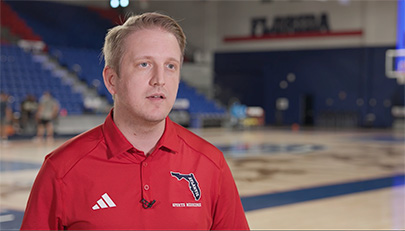
Education
Aging Boomers Driving Advances in Hip and Knee Reconstruction
4 min. read
Baptist Health Orthopedic Care
Not quite ready to throw in the towel on the active lifestyles they’ve enjoyed much of their lives, an estimated 700,000 Americans – many of them aging baby boomers – will choose to have a hip or knee replacement this year, experts say.
Whether an ailing joint is caused by osteoarthritis, rheumatoid arthritis, osteonecrosis, injury or just plain overuse, joint reconstruction can make a world of difference for many patients. And a hip or knee replacement today offers the latest advances in materials, technologies and techniques.

Alexander Gaukhman, M.D., an orthopedic surgeon with Baptist Health Orthopedic Care in Boca Raton
“In this day and age, patients are living longer and healthier lives and are staying active far later in life,” says Alexander Gaukhman, M.D., an orthopedic surgeon with Baptist Health Orthopedic Care in Boca Raton, a part of Baptist Health. “So when patients sustain an injury, our goal at the Institute is to help them regain their function, mobility and quality of life as quickly as possible.”
Dr. Gaukhman, who sub-specializes in adult hip and knee reconstruction, says such procedures have come a long way in recent decades. “Hip and knee replacements have been done for the past 60 to 70 years but only in the past few decades have we seen an exponential improvement in materials, outcomes, longevity and success,” Dr. Gaukhman says. “Patients can expect a very tangible improvement after surgery.”
Much research in the past decade or so has gone into decreasing the wear – and thus increasing the longevity – of the plastic or modular components used in hip and knee reconstruction, according to Dr. Gaukhman. “The way in which the plastic portions of the new joints are now being processed and manufactured has contributed greatly to their longevity and long-term success,” he says.
Surgical techniques have advanced as well, Dr. Gaukhman says. “Hip and knee reconstruction is much less invasive than it was decades ago and is typically performed with robotic surgery though a smaller incision,” he notes. “This directly benefits the patient through decreased blood loss and less soft-tissue destruction from open surgery and more accurate positioning of the new joint’s components. It also allows for a faster recovery and a decreased risk of having to undergo revision or ‘redo’ surgery.”
Faster recoveries for joint reconstruction
One of the biggest changes, he says, has come in the recovery required for hip reconstruction, which just 25 years ago required a two- to three-week hospital stay and months of physical therapy. Now, says Dr. Gaukhman, his patients are up and walking within a couple of hours and most of them are able to go home the same day.
“Most of my surgeries can be performed under a spinal anesthetic without the need for general anesthesia,” Dr. Gaukhman says. “Patients are asleep during surgery and feel no pain from the hip down, but there’s less blood loss and less nausea and they feel more comfortable when they wake up, which means they’re able to initiate their rehabilitation faster.”
For the first two weeks following surgery, patients recover at home doing their own physical therapy exercises, says Dr. Gaukhman. Then, after their two-week follow-up exam, they can proceed to outpatient therapy. Most patients are able to return to their normal daily activities and get back to work within four to six weeks, he says.
Joint reconstruction not just for older adults
Almost everyone is a candidate for hip or knee replacement, says Dr. Gaukhman. “If you have exhausted all conservative treatments and still have daily pain that affects your quality of life, you may want to speak to a specialist about joint reconstruction,” he says. Conservative treatments include anti-inflammatory medications – oral, topical or injectable – as well as physical therapy, weight loss and other strategies, but not everyone finds they provide long-term relief.
Some patients have higher risk of complications based on their history, co-morbidities, age and gender, Dr. Gaukhman says, so it’s up to the surgeon, in consultation with the patient and other specialists, to calculate the relative risk.
Also, ailing joints are no longer an “old age” problem. Dr. Gaukhman says that the patients he sees are “definitely getting younger” and want a higher level of function and performance from their joints. “A lot of my patients are people in their 30s and 40s who are very active in sports and have been all their life. Now they have pain and dysfunction they didn’t use to have and they’re motivated to do something about it,” he says.
A gold standard of treatment for patients
Where patients have their surgery matters, according to Dr. Gaukhman, who says up to 25 percent of the surgeries he performs are revisions, or “redo surgery,” resulting from a failed procedure.
Dr. Gaukhman says the Orthopedic Institute is staffed by orthopedic surgeons in all the different sub-specialties – shoulder; elbow; hand; hip and knee; and foot and ankle. “We provide a gold standard of treatment for patients that can help them decrease their pain and regain their function and mobility more rapidly,” he says. “And if there is ever an issue or complex problem that requires multiple experts, all of them are here under one roof and operating at Boca Raton Regional Hospital.”
Surgery isn’t always the only option, says Dr. Gaukhman, who acknowledges that some patients are reluctant to take that step. “There are a lot of non-operative measures we can take that may provide relief, but your best bet is to seek an expert evaluation from an orthopedic surgeon, who can explain whether or not you’d benefit from joint reconstruction and what your other options are,” he says.
Healthcare that Cares
Related Stories
View All Articles
E-Bike, E-Scooter Head Injuries Surge as Their Popularity Spurs More Hazards
March 7, 2024
2 min. read

Baptist Health Surgeon Helps FAU College Athletes Stay Healthy
January 31, 2024
4 min. read
Video

Treating Top Tennis Players in Delray Beach Tourney Takes a Team
January 25, 2024
3 min. read